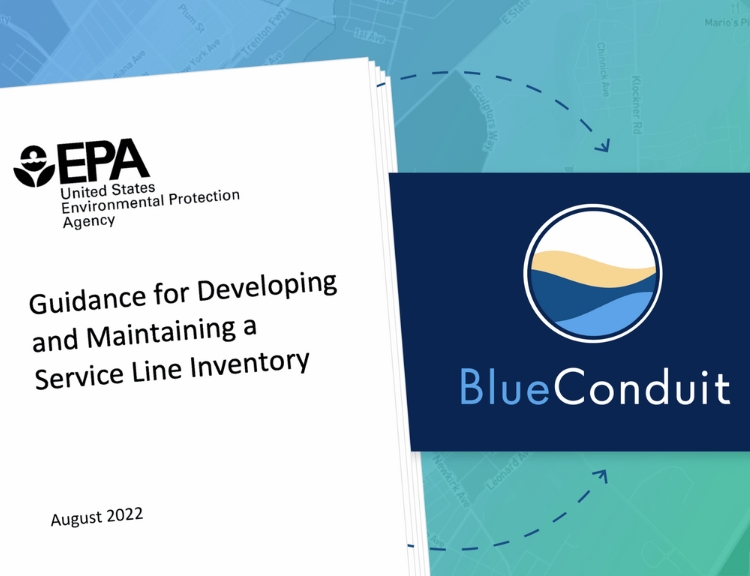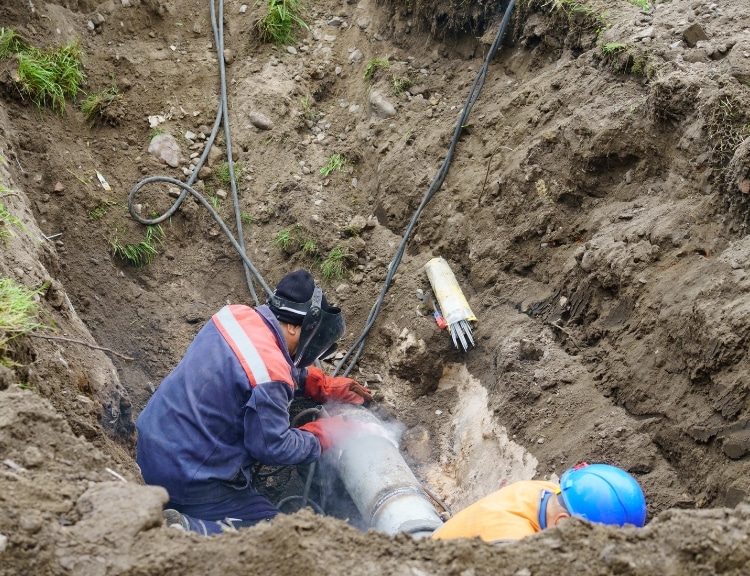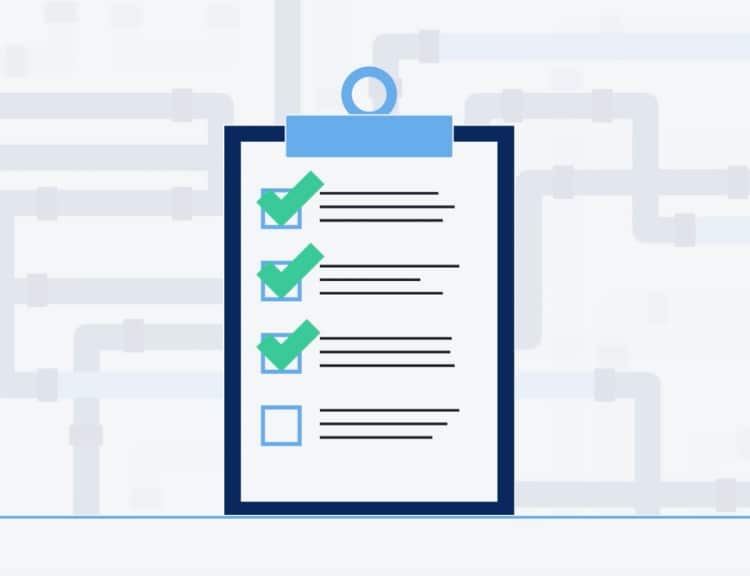On August 4, 2022, the U.S. Environmental Protection Agency (EPA) released its Service Line Inventory Guidance. On the EPA’s LCRR page, you can find its Guidance for Developing and Maintaining a Service Line Inventory (PDF) and an Inventory Template (XLS). BlueConduit is proud to have our work cited in several sections of the Guidance, including the section on developing the inventory, as well as the section on predictive modeling.
From the press release:
Specifically, EPA’s new Guidance for Developing and Maintaining a Service Line Inventory:
US EPA Press Release August 4, 2022 (full text)
- Provides best practices for inventory development and risk communications.
- Contains case studies on developing, reviewing, and communicating about inventories.
- Includes a template for water systems, states, and Tribes to use or adapt to create their own inventory.
- Highlights the importance of prioritizing inventory development in disadvantaged communities and where children live and play.
Inventory Planning in the Lead Service Line Inventory Guidance
In Section 3.3, Selecting an Inventory Format, the Guidance mentions electronic spreadsheets and databases and pulls the following recommendations from ASDWA and BlueConduit’s joint whitepaper on lead service line inventory.
General recommendations for preparing a spreadsheet inventory from a white paper by the Association of State Drinking Water Administrators (ASDWA) and BlueConduit (2020) include the following:
US EPA Guidance for Developing and Maintaining a Service Line Inventory 3-4 (PDF)
- Each home/service line is a row in the spreadsheet.
- Each column refers to different data points available for each service line (e.g., address, installation date, service line materials classification, and source of information).
- System-owned and customer-owned portions, if applicable, are tracked separately.
- Information regarding goosenecks, pigtails, and connectors is tracked separately.
- Labeling is consistent across the data, and the spreadsheet has a data dictionary to define the column headers.
- Previous information is not lost when new information is found, which will help the utility evaluate the accuracy of historical records.
Machine Learning in Lead Service Line Inventory Guidance
A key factor in the success of predictive modeling is the use of representative data. Using a representative set of known data on service line material is important in maximizing accuracy and reliability and minimizing bias.
US EPA Guidance for Developing and Maintaining a Service Line Inventory 5-17 (PDF)
The EPA’s Guidance mentions our work and machine learning in section 5.5: Predictive Modeling. This section cites research conducted on machine learning predictions in Flint, Michigan by BlueConduit co-Founders Jacob Abernethy and Eric Schwartz as well as Chief Data Scientist Jared Webb, Head of Engineering Alex Chojnacki, and Arya Farhi. The work is detailed in Abernethy et al 2018. We have advocated for ensuring representative data powers machine learning predictive models.
Here are a subset of the key points to remember in Section 5: Service Line Investigation Methods.
LCRR Requirements
- Water systems should be aware of identification methods provided or required by their state under the LCRR (40 CFR §141.84(a)(3)(iv)).
Recommendations (Not Required under the LCRR)
…
US EPA Guidance for Developing and Maintaining a Service Line Inventory 5-18 (PDF)
- Predictive Models have been used to estimate the probability that a service line is lead, prioritize areas for service line investigations, and to expedite LSLR.
- Water systems should select the method(s) that are best suited to their particular distribution system and community, considering cost, labor skill requirements, disruption to homeowners, overall time, and accuracy.
Service Line Investigation Methods Include Predictive Modeling

Unknowns in Service Line Inventory Guidance
In Section 6, Developing and Updating the Inventory, the Guidance confirms that the inventory must include both the public and private sides of a service line.
US EPA Guidance for Developing and Maintaining a Service Line Inventory 6-1 (PDF)
- The initial inventory must include all service lines regardless of ownership (40 CFR §141.84(a)(2)).
- The initial service line inventory must use historical records as described in Chapter 4 (40 CFR §141.84(a)(3)(i)-(iii)), information gathered during normal operations as described in Section 3.4, and any resource, information, or identification method provided by or required by the state (40 CFR §141.84(a)(3)(iv) and (a)(5)).
- Non-lead must be determined not to be lead or galvanized requiring replacement (GRR) through an evidence-based record, method, or technique (40 CFR §141.84(a)(4)(iii)).
- If the water system is unable to demonstrate that the galvanized service line was never downstream of a lead service line (LSL), it must presume there was an upstream LSL and classify it as GRR (40 CFR §141.84(a)(4)(ii))
Section 6.2 details how field inspections should inform and prioritize the lead service line inventory and replacement process,
EPA recommends that systems conduct on-site investigations to reduce the number of unknowns in the system as quickly as possible.
US EPA Guidance for Developing and Maintaining a Service Line Inventory 6-6 (PDF)
The section details ways to prioritize field inspections including:
- Consider vulnerable and environmental justice communities
- Target areas with the most unknowns for inspection
- Prioritize by the likelihood of finding lead
- Prioritize where active replacement is happening
- Use field investigations to verify historical records (example – Michigan EGLE Minimum Service Line Material Verification Requirements (PDF))
This section concludes with this recommendation:
EPA discourages water systems from submitting an initial inventory with all unknowns.
US EPA Guidance for Developing and Maintaining a Service Line Inventory 6-15 (PDF)
Public Access for Service Line Inventories
US EPA Guidance for Developing and Maintaining a Service Line Inventory 7-12 (PDF)
- Water systems must make an inventory of the lead and GRR service lines publicly accessible. The publicly accessible inventory must include a location identifier associated with each lead or GRR service line (40 CFR §141.84(a)(8)(i)). The identifier could be a specific address; however, this is not required under the LCRR.
- Water systems serving more than 50,000 people must provide their inventory online (40 CFR §141.84(a)(8)(ii)).
In Section 7’s Key Points to Remember, the Guidance mentions an online map is an acceptable way to publish the information, and cites Woods and Webb (2021) as one of the resources for accessible and inclusive map development. That paper was co-written by BlueConduit’s Chief Data Scientist Jared Webb, about the work done in building a map of lead pipe locations for Flint Michigan.
An interactive online mapping application can be an effective means for distributing
service line inventory information and allows users to comprehensively evaluate a water system’s service line materials anywhere there is access to a basic computer and internet.…
EPA suggests water systems update their inventories in real-time or as close as possible
US EPA Guidance for Developing and Maintaining a Service Line Inventory 7-12 (PDF)
How BlueConduit Helps with Lead Service Line Inventories
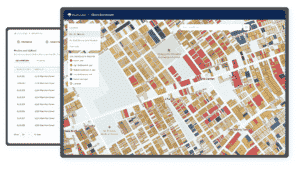
The BlueConduit platform provides machine learning predictions to power lead service line inventories and replacement programs.
Our process and platform supports the development of lead service line inventories and replacement programs:
- from building the inventory from historical records
- through field verification and replacements
- to reporting the inventory to state regulators.
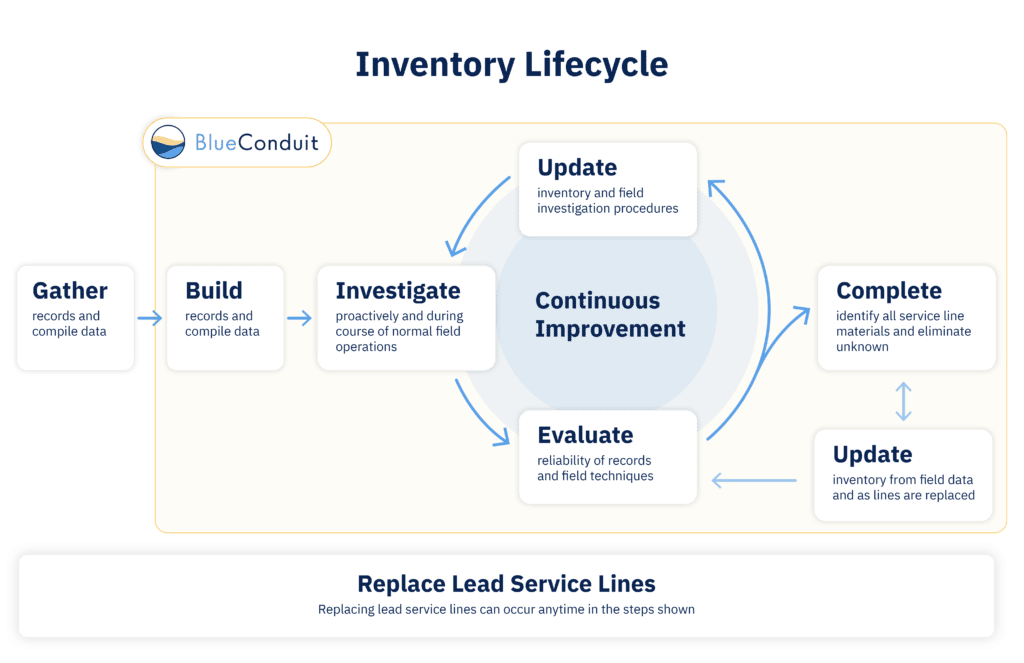
Our predictions help utilities prioritize lead replacement to maximize use of funds and minimize public health risk. As the lead service line replacement program unfolds, the platform provides clear communications to the public through publicly available maps of predictions and replacements.
See how cities like Toledo, Ohio have used our predictions to shave time off of and unlock federal funding for their lead service line replacement program. The EPA Guidance mentioned the City of Detroit’s efforts in removing lead service lines with predictive modeling.
Wondering if your state accepts predictive modeling for service line inventories? Check our state guidance map.
See how it works, or take a platform tour.
Get a demo to see how we can help your water utility get ahead of the requirements and get the lead out of the ground.

